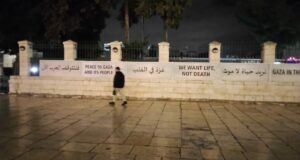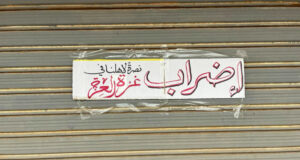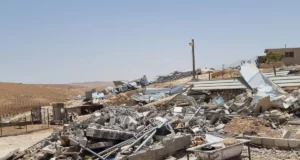by: Lina
When I first decided to go to Palestine to teach kids English and yoga my main concerns were managing the kids’ behavior, assessing their needs and maintaining their interest. After all, those are the most challenging issues I face everyday in my classroom in Philadelphia. In the US I rarely get through an entire unit and to actually teach without a behavior related incident interrupting class is a very rare event. I quickly found it to be quite the opposite in Tel Rumeida which left me feeling like a fish out of water in the beginning.
I arrived in Palestine on a Tuesday, attended nonviolent resistance training about Tel Rumeida on Wednesday which was extremely intimidating yet necessary and helpful. I hung out in Jerusalem on Thursday and headed to Tel Rumeida on Friday to observe Katie’s art class and to meet some of the kids I would be teaching as well as the person who would help me translate in the classroom. The kids were very well behaved for Katie. They seemed to be very motivated and enjoyed her lesson. This was a good sign. The translator, a local university student named Ibrahim, helped more than I expected. I began to worry that language was going to be a larger barrier than I was used to at home since my Arabic was limited at the time to only basic greetings. At home I can speak my students’ language enough to translate on my own.
Ibrahim helped organize the classes of which each consisted of 10-15 kids. One class for girls under the age of 12, one for girls over 12 years and one for boy up to 12 years. Their levels varied in reading and writing but they were all around the emergent or beginner level in listening and speaking, therefore this is where I decided to focus my lessons. As any experienced teacher knows it can take several weeks sometimes months to get into a groove, so I didn’t want to waste anytime as I was only going to be teaching English 3 days a week, an hour each session, for a total of 4-weeks. As for the yoga, this would be 1 day a week for an hour. I knew that would be a brand new experience for the kids so I was also a little worried about how they would perceive me and the concept of yoga overall. Sometimes in very religious communities, such as Tel Rumeida, people view yoga as taboo or voodoo. I knew that I would need to be sensitive to their cultural and religious beliefs.
English Lessons
We started classes immediately the following day. I was a bit nervous because not only did I want them to like me and enjoy the classes but I also wanted them to learn to speak English. I was greeted with a handshake by every student! Wow, such respect from the start! Each class started that way as well. They also all came to class fully prepared to learn with pencils and notebooks and of course enthusiasm and an intense interest in learning English. A stark contrast to the kids I teach in the US who rarely come to class prepared. I was kind of shocked when one student forgot her notebook and Ibrahim told her to go home and get it and not to forget next time or she will not be allowed to come to class. He mentioned that it is unacceptable to come to school unprepared in Palestine. Unfortunately being unprepared is more of the norm where I teach.
The first lesson started out with simple questions and responses such as “What is your name?” “My name is Roba.” And “How old are you?” “I am 8 years old.” After assessing their levels mostly through conversation I then created an entire unit as this was my own project and a curriculum was not being provided. I was a bit worried because I had never really taught without the aid of a curriculum but welcomed the freedom to be as creative as I wanted. I had brought along a few of my own materials which included workbooks for photocopying, phonics readers, music language CDs, and a book for lesson planning ideas. I then relied on the Internet and fellow teaching friends at home for other creative ideas. I was also able to pick up other materials in Hebron and Ramallah, for less than half the price it would have cost in the US. Sometimes it was difficult because I could not find enough manipulatives relative to the lessons so I needed to improvise more often than not. Also, I typically teach up to the 4th grade at home, or up to 11 years old, and in Tel Rumeida I had high school students mixed into the classes. I took advantage of the situation by having the older students assist the younger ones.
Once I got a better feel for how comfortable they were speaking, and everyone seemed to enjoy the opportunity to speak as most children do, I decided to create a base goal for the lessons. The goal was to be able to communicate with internationals basically in case of an emergency. The majority of the lessons consisted of building vocabulary such as settlers, settlement, throw and rocks as well as directional prepositions, how to give directions and follow commands, how to describe things and people and how to read a map of their own community. I was told that this was the first time they ever saw a map of Tel Rumeida. Amazing! I felt a little sad and uneasy teaching for this purpose in the beginning but the lessons needed to reflect upon their personal experiences, and unfortunately this was their reality. Of course, we did find time to escape and talk about other things such as their homes and families.
I ended up not being so concerned about their level of interest in learning because they were always so eager and enthusiastic and participated even when I thought the lesson was not going as well as I as wanted or if the content was a bit difficult. I even gave them homework assignments which most of them did with such enthusiasm and pride that I brought most of their work back with me to show my students here at home. Perhaps I’ll be able to set a spark in students’ motivation here. I really think that my students here can learn something from the kids in Tel Rumeida.
Even some of the international volunteers would report back to me that the kids would approach them and ask them the questions I was asking during our lessons such as “Where are you from?” and then explain the proper way to respond. The most amusing incident I recall hearing about followed a lesson on commands. I taught the kids things like stand up, sit down, touch your toes for use in our yoga lessons. After the lesson they approached the internationals sitting at their posts and yelled to them to stand up and sit down. The internationals were amused and played along. I would also fill in the internationals on what I was teaching and how they could help. Everyone did their best to reinforce the lessons. It was really a community effort.
Yoga classes
Yoga classes were held for one hour, one day a week. I have to admit that the yoga classes were the most enjoyable for both me and the kids. My worries about their perceptions of yoga were quickly diminished after the first class. Not only was it a great way for them to learn English and exercise but it was a great way for all of us to bond. Even the boys enjoyed it! The older girls focused more on holding positions and proper positioning while the younger ones allowed themselves to be silly and fall where their bodies took them. I taught them how to relieve stress through breathing exercises which I hope they practice in the future. We sang songs to help them remember series of positions like sun salutations which the little ones thoroughly enjoyed belting out at the top of their lungs! They were so flexible and willing to try any position. It was nice to see them smiling and full of energy!
It was also especially nice to see the older girls exercising and having fun. In Tel Rumeida you do not see girls outside. They spend most of their time inside their own homes, visiting friends in their homes or within the confines of the grounds of their family’s home. They rarely get to run around and exercise. Some of the girls were aware of stretching exercises that they said they learned from television and gym class at school. Yoga though was new to them and they initially associated it with meditation. They seemed really eager to learn more once they experienced it. I always felt on top of the world after a yoga session with them.
Reflection
The most impressive thing besides being able to actually teach and not have to constantly be interrupted for discipline problems was that the younger girls would line up outside the community center where classes were held at least 30 minutes early! When I asked why they did this they said it was because they wanted to be first in line! I was astonished! I wanted to cry, of course tears of joy! At home I have to drag the kids from the hallway into my classroom. In Palestine, kids live under occupation in extreme poverty and yet they are so motivated to learn. They came to class prepared with pencils and notebooks unlike kids in my school in the US. Their parents and the community in general stress the importance of education and show much respect towards teachers. I would occasionally be approached on the street by mothers welcoming and thanking me for teaching their children. I rarely receive expressions of thanks in the US. I rarely receive respect from parents and students. I didn’t want to leave Tel Rumeida. I fell in love with the kids and with being treated with respect.
Most of the kids were just beginning to understand me on their own without Ibrahim’s help at the end. I hope that they keep practicing. They begin learning English now in the first grade but they do not typically have a native English speaking teacher to teach them, so most considered this a great opportunity to take advantage of. If anyone reading this is considering teaching kids in Palestine, especially in Tel Rumeida, I must say please do it! You won’t regret it. The experience, the place, the people and most importantly the kids will capture your heart and change your life forever, in the most positive way. I say this because this is exactly what happened to me and I wouldn’t have had it any other way.
I will return one day, insh’allah!
 International Solidarity Movement Nonviolence. Justice. Freedom.
International Solidarity Movement Nonviolence. Justice. Freedom.







